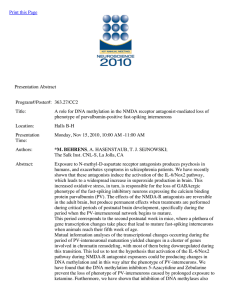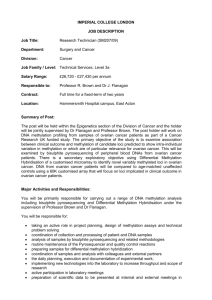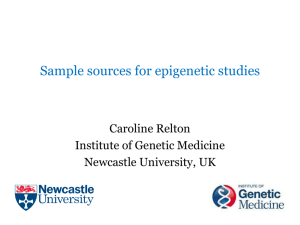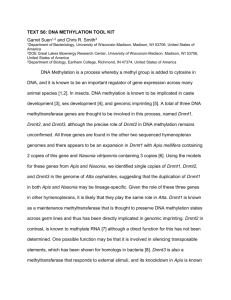A survey of DNA methylation across social insect species, life
advertisement
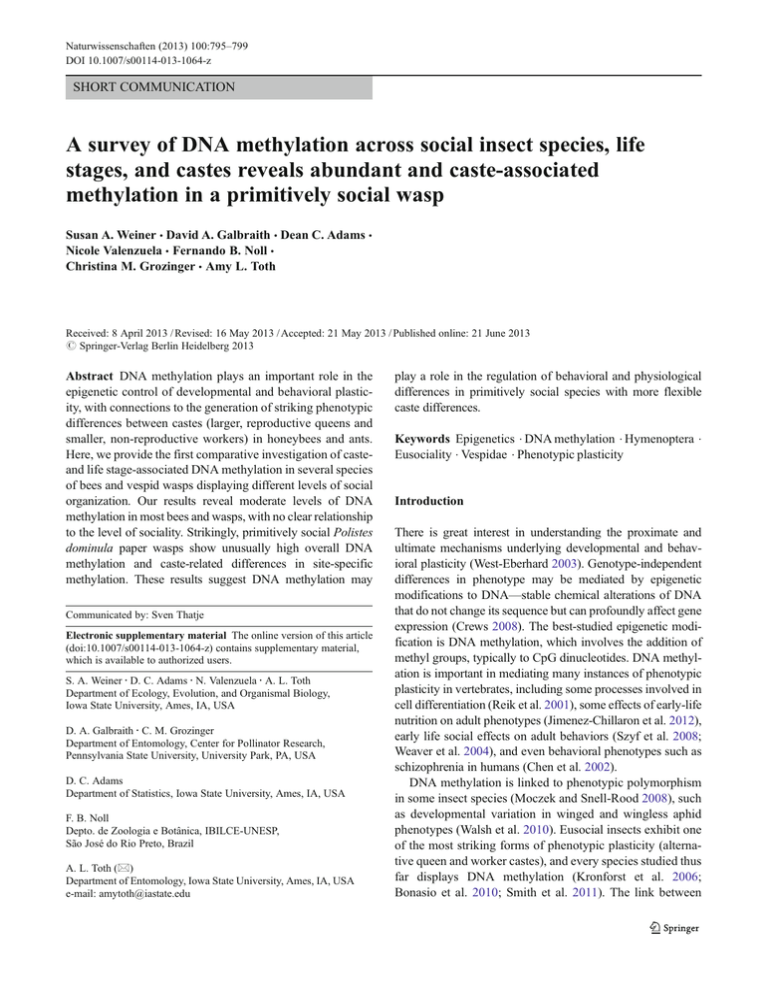
Naturwissenschaften (2013) 100:795–799 DOI 10.1007/s00114-013-1064-z SHORT COMMUNICATION A survey of DNA methylation across social insect species, life stages, and castes reveals abundant and caste-associated methylation in a primitively social wasp Susan A. Weiner & David A. Galbraith & Dean C. Adams & Nicole Valenzuela & Fernando B. Noll & Christina M. Grozinger & Amy L. Toth Received: 8 April 2013 / Revised: 16 May 2013 / Accepted: 21 May 2013 / Published online: 21 June 2013 # Springer-Verlag Berlin Heidelberg 2013 Abstract DNA methylation plays an important role in the epigenetic control of developmental and behavioral plasticity, with connections to the generation of striking phenotypic differences between castes (larger, reproductive queens and smaller, non-reproductive workers) in honeybees and ants. Here, we provide the first comparative investigation of casteand life stage-associated DNA methylation in several species of bees and vespid wasps displaying different levels of social organization. Our results reveal moderate levels of DNA methylation in most bees and wasps, with no clear relationship to the level of sociality. Strikingly, primitively social Polistes dominula paper wasps show unusually high overall DNA methylation and caste-related differences in site-specific methylation. These results suggest DNA methylation may Communicated by: Sven Thatje Electronic supplementary material The online version of this article (doi:10.1007/s00114-013-1064-z) contains supplementary material, which is available to authorized users. S. A. Weiner : D. C. Adams : N. Valenzuela : A. L. Toth Department of Ecology, Evolution, and Organismal Biology, Iowa State University, Ames, IA, USA D. A. Galbraith : C. M. Grozinger Department of Entomology, Center for Pollinator Research, Pennsylvania State University, University Park, PA, USA D. C. Adams Department of Statistics, Iowa State University, Ames, IA, USA F. B. Noll Depto. de Zoologia e Botânica, IBILCE-UNESP, São José do Rio Preto, Brazil A. L. Toth (*) Department of Entomology, Iowa State University, Ames, IA, USA e-mail: amytoth@iastate.edu play a role in the regulation of behavioral and physiological differences in primitively social species with more flexible caste differences. Keywords Epigenetics . DNA methylation . Hymenoptera . Eusociality . Vespidae . Phenotypic plasticity Introduction There is great interest in understanding the proximate and ultimate mechanisms underlying developmental and behavioral plasticity (West-Eberhard 2003). Genotype-independent differences in phenotype may be mediated by epigenetic modifications to DNA—stable chemical alterations of DNA that do not change its sequence but can profoundly affect gene expression (Crews 2008). The best-studied epigenetic modification is DNA methylation, which involves the addition of methyl groups, typically to CpG dinucleotides. DNA methylation is important in mediating many instances of phenotypic plasticity in vertebrates, including some processes involved in cell differentiation (Reik et al. 2001), some effects of early-life nutrition on adult phenotypes (Jimenez-Chillaron et al. 2012), early life social effects on adult behaviors (Szyf et al. 2008; Weaver et al. 2004), and even behavioral phenotypes such as schizophrenia in humans (Chen et al. 2002). DNA methylation is linked to phenotypic polymorphism in some insect species (Moczek and Snell-Rood 2008), such as developmental variation in winged and wingless aphid phenotypes (Walsh et al. 2010). Eusocial insects exhibit one of the most striking forms of phenotypic plasticity (alternative queen and worker castes), and every species studied thus far displays DNA methylation (Kronforst et al. 2006; Bonasio et al. 2010; Smith et al. 2011). The link between 796 DNA methylation and sociality is best studied in honeybees. Differences in gene-specific DNA methylation patterns have been associated with caste determination (Elango et al. 2009; Lyko et al. 2010; Bonasio et al. 2012; Smith et al. 2012). Queen larvae have overall lower levels of DNA methylation than workers (Shi et al. 2013), but these levels do not differ in adults (Lyko et al. 2010). Strikingly, inhibition of de novo DNA methylation led worker-destined larvae to develop into queens (Kucharski et al. 2008). DNA methylation in honeybees is also implicated in memory formation (Lockett et al. 2010), and age-related changes in worker behavior (Herb et al. 2012), suggesting that methylation can influence shorter-term behavioral processes. In a comparative study, roughly equal overall DNA methylation levels were found in two ant species with different levels of caste polymorphism, but the species with a more rigid caste system had more differentially methylated genes (Bonasio et al. 2012). A non-quantitative survey of DNA methylation hinted that primitively eusocial Polistes wasps might show high DNA methylation compared to other hymenopterans (Kronforst et al. 2006), although comparisons across species, castes or life stages were not conducted. Thus, the existing evidence is inconclusive on whether the extent of DNA methylation is related to level of sociality. The seeming importance of DNA methylation in caste differentiation and worker behavior in honeybees and ants suggests an interesting question—is DNA methylation critical only in caste differentiation in highly derived social systems, in which caste differences are fixed during pre-adult development? Or, does DNA methylation also mediate caste or behavioral variation in “primitively” social species with less defined castes? If the latter, genomic flexibility afforded by DNA methylation may potentially aid the evolution of alternative caste phenotypes (Weiner and Toth 2012). Thus, understanding the presence and role of DNA methylation across lineages, including primitively social species, is critical. The paper wasp family Vespidae is ideal for comparative studies of DNA methylation. Vespid sociality originated independently from either honeybees or ants (Hines et al. 2007), and different species have varying levels of sociality, ranging from completely solitary species through highly eusocial species (Ross and Matthews 1991, Supplementary Fig. 1 in Online Resource). Here, we test the hypothesis that DNA methylation varies among species that differ in level of sociality by using methylation-sensitive amplified fragment length polymorphism (AFLP) analysis across multiple bees and wasps. We selected several species displaying a range of social behavior, including a primitively eusocial species (Polistes dominula) with no morphological caste differences, in which behavioral and physiological differences define castes, four highly eusocial wasps exhibiting morphological caste dimorphism (Apoica flavissima, Polybia occidentalis, and Polybia paulista and Dolichovespula maculata), and Naturwissenschaften (2013) 100:795–799 one highly eusocial wasp exhibiting a secondary loss of caste dimorphism (Metapolybia docilis). Within the bees, we examined Bombus impatiens, which displays caste dimorphism, but exhibits more intermediate eusociality because of small colony size and dominance interactions among workers. Finally, we examined one advanced eusocial bee, Apis mellifera, which has strong caste dimorphism and large colony size. In a subset of these species, we looked for evidence of caste- and life stage-related differences in overall DNA methylation levels, as well as caste- and stage-specific differences in site-specific patterns of DNA methylation. Methods Detailed methods are provided in the Online Resource along with details on sample sizes (Supplementary Table 2). We sampled heads from one to five adult queens and workers of all species listed above. For a subset of species, when available, we also sampled four to five early-stage pupae, identified by their white color preceding melanization. Pupae possess morphological features that permit identifying easily the caste (except in P. dominula) and sex of individuals. One pooled DNA sample from ~30 adult male and female Drosophila melanogaster was used as negative control. Methylation-sensitive restriction enzymes, plus standard AFLP analysis, provided scorable fingerprints of anonymous methylated and unmethylated CG sequences within the genome. We used a protocol previously used for Hymenoptera (Kronforst et al. 2006). “Overall methylation level” was calculated by dividing the number of unique peaks from methylation-sensitive digests (Supplementary Fig. 2, Online Resource) by the total number of peaks. We compared mean methylation levels for each species, caste, and stage using Kruskal–Wallis ANOVAs. We then used permutational MANOVA, a multivariate method (Zapala and Schork 2006) not previously applied to AFLP data, to evaluate differences in AFLP expression in the four species for which we had samples from adults and pupae (A. mellifera, B. impatiens, D. maculata, and P. dominula). Briefly, data were converted into binomial form to obtain a character matrix of “site-specific DNA methylation” and tested for individual site difference using Fisher exact tests with Bonferroni corrections. We then computed a distance matrix based on the binomial data, which was used for permutational MANOVA and principal coordinates analysis. Statistical analyses were performed in R (R Core Development Team 2008). Results We found variable mean levels of “overall DNA methylation” across species, from 0 % in Drosophila to ~6 % in P. Naturwissenschaften (2013) 100:795–799 dominula. P. dominula showed significantly higher levels than any of the other species (Fig. 1, ANOVA: F=5.72, df =7, p<0.001). We found no difference in overall DNA methylation between castes or stages for any of the four species analyzed (A. mellifera: χ2 =1.4279, df=3, p value= 0.699, B. impatiens: χ2 =.0343, df=3, p value=0.1693, D. maculata: χ2 =3.0176, df=3, p value=0.3889, P. dominula: χ2 =3.354, df=3, p value=0.3402). A few individual fragments showed caste- and stagerelated differences, but none of these were significant after Bonferroni correction (Supplementary Table 1, Online Resource). Based on uncorrected p values, significant caste differences were found for A. mellifera (two of 152 fragments) and P. dominula (three of 74 fragments), and significant stage differences were found for B. impatiens (three of 185 fragments), and D. maculata (three of 239 fragments). A permutational MANOVA on “site-specific DNA methylation” (considering all fragments) showed no caste or stage effects in A. mellifera, B. impatiens, or D. maculata (Table 1). However, we found significant caste-related site-specific DNA methylation in P. dominula, with no significant effects of stage or caste×stage interaction (Table 1). There was a significant caste×stage interaction for D. maculata. Principal coordinates analysis permitted visualizing the separation between castes for P. dominula; such patterns were not apparent for the other three species (Fig. 2). Discussion Here, we provide the first comparative study of DNA methylation levels in multiple hymenopterans to examine the ontogeny of caste development. Our most striking finding is the potential for abundant and caste-specific DNA methylation in a primitively social species, Polistes dominula. This finding suggests that DNA methylation might be Fig. 1 Percent of methylated restriction sites (mean ± standard error), reflecting DNA methylation in the genomes of a combined set of queens and workers from eight different Hymenoptera species, with Drosophila melanogaster as a negative control. Sample sizes are shown within bars. ***ANOVA: df=7, F=5.72, p<0.001 797 important in at least some primitively social species with less-defined caste phenotypic differences. We hypothesize that DNA methylation mediates the lifelong caste, behavioral, and physiological flexibility of this species. Indeed, recent studies in honeybees suggest more dramatic changes in DNA methylation in association with behavioral flexibility within the worker caste, relative to morphological caste differences (Herb et al. 2012). The AFLP method provides a useful preliminary survey of DNA methylation patterns, without requiring pre-existing knowledge about the genome or gene sequences of the species in question. Nonetheless, it is important to note its limitations. Because restriction enzymes digest DNA sequences at restriction sites haphazardly across the genome, many relevant, methylated fragments in each species’ genome are certainly missed. Thus, these results provide a snapshot of a small number of anonymous fragments and encompass only a few dozen of likely thousands of methylated sites (Bonasio et al. 2012). We also have no information about where in the genome these fragments were located, e.g., whether they were associated with introns or exons. Therefore, these results should not be interpreted as indicative of the absence of caste- or stage-related differences in DNA methylation when these effects were not detected. For instance, our data show only weak evidence (Supplementary Table 1, Online Resource) of caste-related DNA methylation in honeybees; yet, at least 550 genes exist with differential methylation between adult queen and worker castes in honeybees (Lyko et al. 2010). Thus, this approach has limited power to detect differences. However, positive findings (e.g., in the case of P. dominula) are highly indicative of true casterelated differences in DNA methylation. Our overall methylation estimates are an order of magnitude higher than reports by Kronforst et al. (2006), perhaps due to differences in restriction enzyme efficiency and/or AFLP scoring protocols. Using a much more sensitive 798 Naturwissenschaften (2013) 100:795–799 Table 1 Summary of permutational MANOVAS testing the effects of caste, stage, and their interaction, based on presence/absence of DNA methylation for all fragments (Table S1) for each species Species Caste (F, p value) Stage (F, p value) Caste × stage (F, p value) Apis mellifera Bombus impatiens Dolichovespula maculata Polistes dominula 1.05, 0.39 0.556, 0.764 0.428, 0.964 4.508, 0.012* 0.56, 0.828 0.207, 1.441 1.263, 0.223 1.113, 0.340 0.574, 0.390 1.110, 0.351 2.738, 0.001* 1.511, 0.217 Significant p-values are bolded and indicated with an asterisk method (bisulfite sequencing), methylation was detected in 1.57 % of CGs in introns and exons in A. mellifera (Lyko et al. 2010). Our AFLP-based estimates (2–3 %) are higher than the bisulfite sequencing-based estimates, but the relative similarity of these estimates is notable given the extreme differences in methodology producing the two estimates. It is important to note that based on our collections of adult A. mellifera and B. impatiens, age differences between queens and workers could confound caste comparisons. Despite the limitations of our AFLP-based estimates, our results confirm some previous results. Namely, we found some evidence of caste-specific methylation in A. mellifera (Supplementary Table 1, Online Resource) and no overall Bombus impatiens b Apis mellifera a 0.15 0.15 0 0 Fig. 2 Principal coordinates (PCoA) plots based on presence/ absence of DNA methylation at anonymous sites in the genomes of individual adults and pupae of four species. Blue dots represent individual queens and red dots represent individual workers differences in the total amount of DNA methylation across queen and worker castes, as in Lyko et al. (2010). Across species, our results indicate that the high overall levels of DNA methylation observed in Polistes are unusual, as we did not find similarly high levels in highly eusocial vespids neither with nor without caste dimorphism, nor in the two bee species examined. Thus, our results on overall methylation levels single out P. dominula as having potentially unusual elements of its DNA methylation system, but reveal no clear connection between overall levels of DNA methylation and level of sociality across species. Most excitingly, our results uncover great potential for studying epigenetic influences on caste in primitively social -0.05 -0.15 0 -0.3 0.4 -0.4 PCoA 1 0.4 PCoA 1 Dolichovespula maculata c 0 Polistes dominula d 0.3 0.15 0 0 -0.3 -0.2 -0.6 0 PCoA 1 -0.8 0 PCoA 1 0.4 Naturwissenschaften (2013) 100:795–799 insects such as P. dominula. Further comparative analyses in social insects, especially those with flexible caste systems, have the potential to improve our understanding of how epigenetic effects may contribute to the evolution of sociality. Acknowledgments We would like to thank Shelby Fleischer and Ermita Hernandez for the bumble bees, Tom Glenn for the honeybees, Sarah Kocher, Bernardo Niño, and Elina Lastro Niño for D. maculata, John Wenzel for the helpful discussions, Naila Canevazzi for the DNA extractions, Daniel Kronforst for the AFLP methods, Ali Berens for the statistical analysis, and members of the Toth laboratory for reviewing the manuscript. This research was supported by the United States Department of Agriculture Award 2008-35302-06024 to ALT and National Science Foundation Award IOS-1051808 to ALT. References Bonasio R, Zhang G, Ye C, Mutti NS, Fang X, Qin N, Donahue G et al (2010) Genomic comparison of the ants Camponotus floridanus and Harpegnathos saltator. Science 329:1068–1071 Bonasio R, Li QY, Lian JM, Mutti NS, Jin LJ, Zhao HM, Zhang P, Wen P, Xiang H, Ding Y, Jin ZH, Shen SS, Wang ZJ, Wang W, Wang J, Berger SL, Liebig J, Zhang GJ, Reinberg D (2012) Genomewide and caste-specific DNA methylomes of the ants Camponotus floridanus and Harpegnathos saltator. Curr Biol 22:1755–1764 Chen Y, Sharma RP, Costa RH, Costa E, Grayson DR (2002) On the epigenetic regulation of the human reelin promoter. Nucleic Acids Res 30:2930–2939 Crews D (2008) Epigenetics and its implications for behavioral neuroendocrinology. Front Neuroendocrinol 29:344–357 Elango N, Hunt BG, Goodisman MAD, Yi SV (2009) DNA methylation is widespread and associated with differential gene expression in castes of the honeybee, Apis mellifera. Proc Natl Acad Sci U S A 106:11206–11211 Herb BR, Wolschin F, Hansen KD, Aryee MJ, Langmead B, Irizarry R, Amdam GV, Feinberg AP (2012) Reversible switching between epigenetic states in honeybee behavioral subcastes. Nat Neurosci 15:1371–1373 Hines HM, Hunt JH, O'Connor TK, Gillespie JJ, Cameron SA (2007) Multigene phylogeny reveals eusociality evolved twice in vespid wasps. Proc Natl Acad Sci U S A 104:3295–3299 Jimenez-Chillaron JC, Diaz R, Martinez D, Pentinat T, Ramon-Krauel M, Ribo S, Plosch T (2012) The role of nutrition on epigenetic modifications and their implications on health. Biochimie 94:2242–2263 799 Kronforst M, David G, Joan S, David Q (2006) DNA methylation is widespread across social hymenoptera. Curr Biol 18:R287–R288 Kucharski R, Maleszka J, Foret S, Maleszka R (2008) Nutritional control of reproductive status in honeybees via DNA methylation. Science 319:1827–1830 Lockett, GA, Helliwell, P, Maleszka R (2010) Involvement of DNA methylation in memory processing in the honey bee. Neuroreport 12:812–816 Lyko F, Foret S, Kucharski R, Wolf S, Falckenhayn C, Maleszka R (2010) The honey bee epigenomes: differential methylation of brain DNA in queens and workers. PLoS Biol 8:e1000506 Moczek A, Snell-Rood E (2008) The basis of bee-ing different: the role of gene silencing in plasticity. Evol Dev 10:511–513 R Development Core Team (2008) R: a language and environment for statistical computing. R Foundation for Statistical Computing, Vienna Reik W, Dean W, Walter J (2001) Epigenetic reprogramming in mammalian development. Science 293:1089–1093 Ross KG, Matthews RW (1991) The social biology of wasps. Ithaca, New York Shi YY, Wei YY, Huang ZY, Wang ZL, Wu XB, Zeng ZJ (2013) Genomewide analysis indicates that queen larvae have lower methylation levels in the honey bee (Apis mellifera). Naturwissenschaften 100:193–197 Smith, CR, Smith, CD, Robertson, HM, Helmkampf, M et al. (2011) Draft genome of the red harvester ant Pogonomyrmex barbatus. Proc Natl Acad Sci USA 108:5667–5672 Smith CR, Mutti NS, Jasper WC, Naidu A, Smith CD, Gadau J (2012) Patterns of DNA Methylation in development, division of labor and hybridization in an ant with genetic caste determination. PLoS One 7:e42433 Szyf M, McGowan P, Meaney MJ (2008) The social environment and the epigenome. Environ Mol Mutagen 49:46–60 Walsh TK, Brisson JA, Robertson HM, Gordon K, Jaubert-Possamai S, Tagu D, Edwards OR (2010) A functional DNA methylation system in the pea aphid, Acyrthosiphon pisum. Insect Mol Biol 19:215–228 Weaver ICG, Cervoni N, Champagne FA, D'Alessio AC, Sharma S, Seckl JR, Dymov S, Szyf M, Meaney MJ (2004) Epigenetic programming by maternal behavior. Nat Neurosci 7:847–854 Weiner SA, Toth AL (2012) Epigenetics in social insects: a new direction for understanding the evolution of castes. Genet Res Int 2012:609810 West-Eberhard, MJ (2003) Developmental plasticity and evolution. Oxford University Press. Zapala MA, Schork NJ (2006) Multivariate regression analysis of distance matrices for testing associations between gene expression patterns and related variables. Proc Natl Acad Sci U S A 103:19430– 19435

